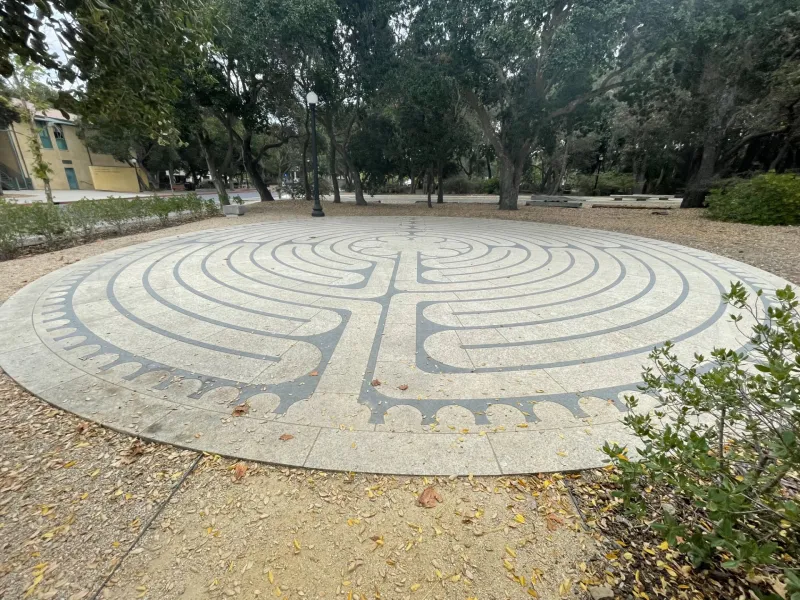COLLEGE 101 students are required to read Jenny Odell’s best-selling book “How to Do Nothing: Resisting the Attention Economy” from this year’s Three Books program. An artist, writer and Stanford professor, Odell offers a treatise for self-cultivation: embrace contemplation and active listening, thereby challenging capitalism’s emphasis on productivity.
She notes that through intervals of silence, we are forced to think more deeply and generate ideas that will contribute meaningfully to public discourse — affirming the core focus of the COLLEGE curriculum on liberal education and attunement. “Saying nothing is a precursor to having something to say,” Odell argues.
Perhaps no other spot on campus serves as a more relevant monument to these ideals than the Windhover Contemplative Center, and in particular, its outdoor labyrinth. After reading that Odell enjoyed spending time in her local rose garden, where there is a series of complex, interlocking mazes inviting introspection, I immediately envisioned the circular labyrinth at Windhover, which is located near my dorm. Even before I arrived at Stanford, I had yearned to tour Windhover and immerse myself in the serene beauty of its sleek architecture and mesmerizing labyrinth.
However, with an onslaught of commitments from NSO to the first few weeks of classes, I somehow never had the chance to visit. Perhaps I felt guilty that I should have been spending my precious time on homework rather than indulging in meditation, or that I should have been spending my time with friends rather than experiencing solitude.
In general, the aggressive pace of Stanford’s hustle culture often precludes the possibility of dedicating time for self-reflection. As a result, many students seem to overlook visiting Windhover. Nonetheless, reading Odell’s advice provided motivation both to explore the labyrinth and to discover the deeply personal art of “doing nothing.”
I began winding my way through the labyrinth by taking off my shoes, and after allowing my bare feet to make contact with the cool stone, I delicately and at first timidly navigated the looping path. As I treaded further and further into the intricate maze — slowing down my pace as I adjusted to the natural rhythm of my footsteps — I released my inhibitions and stopped considering upcoming assignments, classes or social events.
Instead, I became deeply and intensely focused on my journey, with the result that time seemed to slip away. Suspended in a moment of pure contemplation and repose, I forgot the early morning traffic on Santa Teresa Street and the students and professors walking past.
Maintaining my commitment to the singular path, I attained not only a heightened sense of awareness of my physical environment, from the slightly bitter air to the surrounding peaceful woods, but also an acute perception of my own thoughts and emotions. Mirroring my physical act of slowing down, my thoughts became less chaotic as my mind emptied of concerns. As feelings of relaxation spread across my body, I realized that self-awareness can be derived from the simplicity of “doing nothing,” which in turn leads to “deep listening,” enabling a magical experience of attunement to the environment and mind.
The labyrinth at Windhover is inspired by the 12th-century stone labyrinth located within the Cathedral of Notre Dame in Chartres, France. Labyrinths are ancient patterns, employed by human societies for at least five thousand years. Walking the maze with this fascinating historical background in mind, I increasingly felt as if I had transcended the boundaries of my specific time and place and connected to past societies from all across the world, united in navigating the timeless labyrinth.
Since many of the geometric designs in the labyrinth are borrowed from patterns found in nature, my experience also had the restorative impact of enabling immersion among naturally recurring elements.
Odell writes that public spaces serve as examples of “attention-holding architecture,” which intentionally embody an ethos of openness, receptivity and inward reflection. With ties to personal experiences, she captures the importance of communal spaces: physical spheres that are spatially and psychologically distanced from the attention economy, which constantly demands a commercialized productivity and fails to give us the space to breathe and recharge.
She notes that labyrinths, in particular, like her beloved rose garden, facilitate a “dense infolding of attention.” As sanctuaries from linear time and familiarity, leaving these places enables us to return to our lives more focused and aware.
As Plato illuminated in the “Allegory of the Cave,” education is meant to redirect individuals’ sensibilities toward truth, reality and enlightenment. Although public spaces may not yield immediately tangible benefits, they are irreplaceable in refocusing our senses on the natural environment, providing a refuge for leisure and solitude in a world that seeks our unrelenting attention.
As a device-free zone encouraging contemplative silence, Windhover stands as a symbol of the power of self-reflection in liberal education, as well as a physical reminder of the aims of “How to Do Nothing” and the COLLEGE curriculum.
While moments of stillness are scarce on this bustling campus, and there is undoubtedly pressure to “be busy,” I plan to make my visits to the labyrinth at Windhover a regular occurrence during my time at Stanford, and I encourage others to discover their own special spaces to gain invaluable time for tranquility and self-realization.
